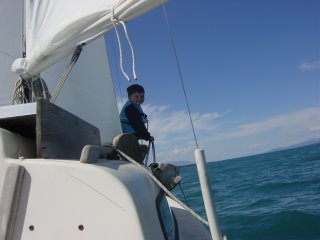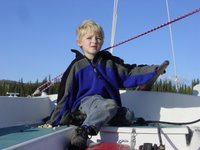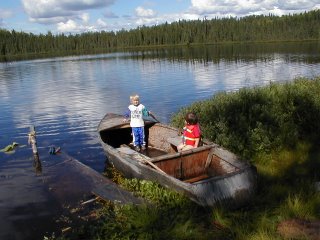
Looking out the window, the thermometer tells me that it's zero degrees. Fahrenheit. It is not unseasonably cold for Alaska – and therein lies the rub. You see, it will be frozen solid here in Fairbanks for at least another month or so, and for the avid sailor this is somewhat problematic. At times like these, sometimes the best you can do is daydream, reminisce, and think about warmer venues.
One such remonition brings me back to early July 2002. The place was Kluane lake, Canada, and the ship was the Laura Ann, a 17.2 foot centerboard cruiser by Vandestadt & McGruer. The Laura Ann was a fully decked boat with a snug cabin, ballasted centerboard and self bailing cockpit. Though I have become accustomed to much larger boats, many fine adventures were brought to me sailing upon her fifteen and a half foot waterline.
The aquamarine waters of Kluane Lake rest tentatively in northwestern Canada. The lake is some 43 miles long, covers 154 square miles, and is fed by the glacial meltwater of the Slims River. During the 1901 gold rush it was busy with water traffic - but now there are very few craft about, and the locals told us that they had not seen a sailboat there for more than a year. In fact, over the time we were there we saw only one other boat, and that one only briefly.
Fruitlessly inquiring after a chart, we were cautioned by the locals (obviously not the sailing type) that the lake was "deep, and cold, and sometimes the wind comes up." These facts were quite well known to us, as it was for these reasons we came to sail. Granted, the glacial water was quite cold, but not extraordinarily so by my measure. That the water was deep was a blessing to the sailor, and the wind was of course an integral part of our plan.
I would be remiss if I did not pass along a word of caution. While Kluane is only a medium sized lake, because of the surrounding mountains it is not to be taken lightly. Hurricane force winds in excess of 120 knots occur periodically, and fierce williwaws come down with regularity when the winds are moving briskly over the mountaintops. There is evidence along the shore that the breakers can carry great force at times, and owing to its long, canyon like geography it is possible to get a very stiff wind with nigh unto forty miles of fetch. The steep, short period waves often exceed 5 feet according to local reports, and the many uncharted shoals shift frequently. There is very little shelter nearby for many areas of the lake, and most all anchorages are exposed from one side or another. This lake is no place for the unwary family in a canoe or open boat.
That said, we felt we were well enough prepared for most things that the lake could throw at us, so we put in at the northern end of the lake. Sailing toward Silver City, we took in the breathtaking vista as we steered a lazy reach southward. As the light began to show signs of its gradual decline, we thought it wise to work towards finding a secure place to spend the night. The question of anchorage was a bit tricky given the prevailing wind and the possibility of williwaws, so we stood out east by northeast for what looked like a sheltered spot on the “chart” - a placemat enhanced by hand sketched details from a topographical map and local commentary.
When we got to our planned anchoring spot, there were three footers bending around the point, and a restful anchorage was not to be had. We beat our way up to a place on the “placechart” where it looked like there might be a mouth to a stream (or maybe just a coffee stain). What we found was a narrow, rocky, winding channel that led to another lake nestled in behind a great bar. The channel was all but invisible until within 75 yards, then it could be barely discerned. The approach to the channel was very shallow even for our scant 10 inch draft (board up), so we anchored off and set out in the kayak to have a closer look.
We found a narrow channel across the outer bar, and with the water nearly flat in the cove decided to give it a go. We set up a rockpile range ashore to guide us in and out, then proceeded to drift inward with the gentle breeze that now prevailed. Following our range, we made it to the channel mouth without incident. The Channel itself, barely wide enough to accommodate our six and a half foot beam while turning, was strewn with giant menacing boulders - many of which rose nearly to the surface. Threading our way in carefully - one man at the helm, one at the bow fending off and giving direction - we managed to get in easily but with very little margin for error.
Once in the protected lake, we set the hook and settled in to the droning hum of the bloodsucking insect horde outside. Window screen and toilet paper. Don't leave home without them. I silently wondered how long we would be stuck here if the wind came up strongly out of the west, and my shipmate Raoul settled into his bunk for a good read.
The rousing aroma of eggs and sausage enticed me out of my cozy bunk, and I awoke to Raoul cooking breakfast on the bridge-plank. Here’s to picking good crew! It was usually more practical to cook out in the cockpit on Laura Ann, as her diminutive size made a galley inside nothing more than a pipe dream. Lack of amenities notwithstanding, Raoul managed a wonderful meal complete with fresh blueberry pancakes, all cooked up with copious quantities of butter. My cardiologist would giggle with anticipation if he watched Raoul cook, but its hard to argue with the taste!
Morning came with striking colors (not ours!!), and in the full light we could truly appreciate the beauty of this "secret" harbor. After breakfast, we took some time in the kayak to explore the quiet lake, nestled as it was among the beautiful cliffs and hills. There was moose and black bear at hand, and we regretted our lack of a telephoto camera to capture the moment. Upon returning to our little floating cocoon, we replaced the shear pin on our tiny outboard and decided to take advantage of the calm conditions to work our way out against the light westerly breeze.
Working upwind, we finally made the channel mouth, started the motor, and raised the board. Now understand - Our tiny 1.2 HP outboard was direct drive. No neutral, no reverse. Just ahead, more or less. Promptly, we struck a boulder with the prop - destroying our last shear pin. It would of course be trivial to jury rig one, but now we were mid channel, wind on the nose, poling among the menacing boulders at a snails pace with all of our might against the building wind. Did I mention that the wind came up? I should have counted on that.
With agonizing effort, we managed to make the outer mouth, but the wind was still on the nose. We had no motor, a narrow channel, and no ability to sail in the depth we had. We continued our efforts with boathook and oar, carefully lining up the range marks astern. At length we crossed the outer bar and found water enough to lower the centerboard a bit. We clawed off the lee shore into the quickly building waves which were breaking over the bar to leward. At first, we could make almost no way against the wind, but with each foot gained, we could lower the board just a bit more, and so on, until finally we had a clear tack to deep water.
Freed of our clever trap, we went on to other adventures. The next days were pleasant enough, with rolling seas of two to three feet, beautiful scenery, pleasant daysails with the children, and so forth.
Despite our difficulties in doing so, choosing the shelter of the harbor given the conditions was a wise choice. Chief among my mistakes was dawdling in the still morning air, giving convection a chance to build. I also could have easily set an anchor outside the bar and led a float in to the mouth of the channel on my way in. With such preparation, I could have picked up the line and kedged my way out handsomely after making the channel mouth. Also, of course, I might have motored out neatly without striking the prop, but looking back it was unwise to assume that this would be the case.
After a few days on the lake, it was time to go. The wind was at about fifteen gusting twenty knots and building out of the west. We reached north toward the only small boat harbor on the lake, where the trailer waited at the boat ramp on the western shore.
Like any boat, Laura Ann had her strong points and her weak ones. The engine was of no use against a blow. Equipped with only a roller furling genoa for a headsail and sail balance that made serious windward work impossible under main alone, a stiff breeze put her at a serious disadvantage when close hauled. If you reefed the genoa, the sail shape was poor enough to seriously hamper windward progress. The angle that could be maintained allowed only minimal gains to windward, and if the tacks were too close together none at all would be had.
With the winds now over twenty knots most of the time, the difficulty lay in fetching the entrance to the harbor. If we waited much longer, we would be forced to bear off to deeper water and heave to or run. We might also close with the windward shore elsewhere and dangle from our ground tackle for the night, or any number of other unpleasant options. We decided to work our way in, knowing that we might have to change our minds if the wind continued to build. To have any chance at all, we would have to come in with all sail flying. Tacking up the narrow channel with sails reefed would put us no closer to our goal, and might well land us on the rocks if we got caught in stays for more than a moment. Alternatively, coming in over canvassed would mean maneuvering among the giant boulders at full speed, and just one chance to get it right or having to turn tail and crash-gibe. To make matters worse, the tiny harbor had no maneuvering room, so even if successful, we would have only seconds to douse the sails and slow down before landing at the dock, dead upwind.
After several thwarted attempts, and losing our boathook overboard during a tack (launched well clear by the jib sheet) we finally got our chance. All sails hoisted, at full speed we made the perfect angle to get inside. One mandatory tack to miss the breakwater - cheerly executed - then dowse the sails without delay. Just enough time to grab the dock with the stern line on the way by, snubbing up with a lurch just short of the ramp. Several seconds of silence followed, as the fact that we had pulled this off without a hitch began to sink in. A quick glance shoreside confirmed Murphy’s law of docking, that a crowd will only be present when you really screw things up.
Well relieved and justifiably impressed, my shipmate and I congratulated each other for a job well done, and put to rest all doubt concerning any stern words that might have been thrown about in the heat of the contest. Noted were some observations: that the boathook took on water and sank almost instantly, to our surprise - and that roller reefing could not be reliably trusted to function in situations such as these. In our case, it worked flawlessly, but if it had not (and it frequently did not) it would surely have cost us the maneuver, our pride, and significant gouging of the hull. In thanks, we poured the rest of the gin overboard for the lady of the lake. Okay, okay, I admit it. Maybe not all the rest.
 On the way up from Ft. Lauderdale last year, it was convenient (if amusing) that most boats gave us a very wide berth while in the waterways, some nearly to the point of running aground. Covered with peeling paint and rust, performing her best "floating ship of doom" imitation, Free Spirit scattered the faint of heart. Somehow our desheveled appearance, along with my 9 year old son giving his presidential wave from atop the cabin trunk gave some the impression that a collision with a lesser vessel was not likely to be of the slightest concern to us:
On the way up from Ft. Lauderdale last year, it was convenient (if amusing) that most boats gave us a very wide berth while in the waterways, some nearly to the point of running aground. Covered with peeling paint and rust, performing her best "floating ship of doom" imitation, Free Spirit scattered the faint of heart. Somehow our desheveled appearance, along with my 9 year old son giving his presidential wave from atop the cabin trunk gave some the impression that a collision with a lesser vessel was not likely to be of the slightest concern to us:











